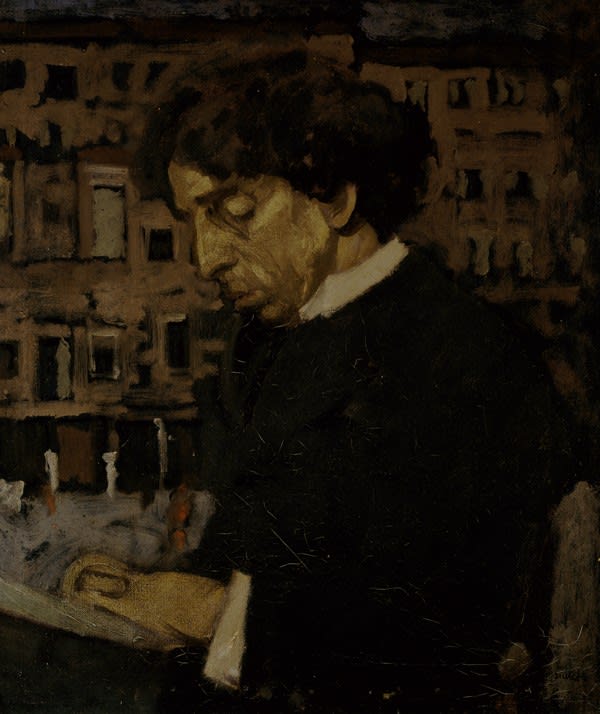Open a larger version of the following image in a popup:
 Walter Sickert, Viscere Mie (James Hyman Fine Art)
Walter Sickert, Viscere Mie (James Hyman Fine Art)
 Walter Sickert, Viscere Mie (James Hyman Fine Art)
Walter Sickert, Viscere Mie (James Hyman Fine Art)
Open a larger version of the following image in a popup:
 Walter Sickert, Viscere Mie (James Hyman Fine Art)
Walter Sickert, Viscere Mie (James Hyman Fine Art)
 Walter Sickert, Viscere Mie (James Hyman Fine Art)
Walter Sickert, Viscere Mie (James Hyman Fine Art)
Open a larger version of the following image in a popup:
 Walter Sickert, Portrait of Israel Zangwill, 1896-98, (National Galleries of Scotland)
Walter Sickert, Portrait of Israel Zangwill, 1896-98, (National Galleries of Scotland)
 Walter Sickert, Portrait of Israel Zangwill, 1896-98, (National Galleries of Scotland)
Walter Sickert, Portrait of Israel Zangwill, 1896-98, (National Galleries of Scotland)
Open a larger version of the following image in a popup:
 Walter Sickert, Mrs Swinton. The Lady in the Gondola, 1905 (Ashmolean Museum, Oxford)
Walter Sickert, Mrs Swinton. The Lady in the Gondola, 1905 (Ashmolean Museum, Oxford)
 Walter Sickert, Mrs Swinton. The Lady in the Gondola, 1905 (Ashmolean Museum, Oxford)
Walter Sickert, Mrs Swinton. The Lady in the Gondola, 1905 (Ashmolean Museum, Oxford)
Open a larger version of the following image in a popup:
 Walter Sickert, Variation on Peggy, 1934-5 (Tate, London)
Walter Sickert, Variation on Peggy, 1934-5 (Tate, London)
 Walter Sickert, Variation on Peggy, 1934-5 (Tate, London)
Walter Sickert, Variation on Peggy, 1934-5 (Tate, London)
Open a larger version of the following image in a popup:
 Detail: Walter Sickert, Viscere Mie (James Hyman Fine Art)
Detail: Walter Sickert, Viscere Mie (James Hyman Fine Art)
 Detail: Walter Sickert, Viscere Mie (James Hyman Fine Art)
Detail: Walter Sickert, Viscere Mie (James Hyman Fine Art)
Open a larger version of the following image in a popup:
 Detail: Walter Sickert, Viscere Mie (James Hyman Fine Art)
Detail: Walter Sickert, Viscere Mie (James Hyman Fine Art)
 Detail: Walter Sickert, Viscere Mie (James Hyman Fine Art)
Detail: Walter Sickert, Viscere Mie (James Hyman Fine Art)
Open a larger version of the following image in a popup:
 Detail: Walter Sickert, Viscere Mie (James Hyman Fine Art)
Detail: Walter Sickert, Viscere Mie (James Hyman Fine Art)
 Detail: Walter Sickert, Viscere Mie (James Hyman Fine Art)
Detail: Walter Sickert, Viscere Mie (James Hyman Fine Art)
Open a larger version of the following image in a popup:
 Detail: Walter Sickert, Viscere Mie (James Hyman Fine Art)
Detail: Walter Sickert, Viscere Mie (James Hyman Fine Art)
 Detail: Walter Sickert, Viscere Mie (James Hyman Fine Art)
Detail: Walter Sickert, Viscere Mie (James Hyman Fine Art)
Open a larger version of the following image in a popup:
 Detail: Walter Sickert, Viscere Mie (James Hyman Fine Art)
Detail: Walter Sickert, Viscere Mie (James Hyman Fine Art)
 Detail: Walter Sickert, Viscere Mie (James Hyman Fine Art)
Detail: Walter Sickert, Viscere Mie (James Hyman Fine Art)
Open a larger version of the following image in a popup:
 Detail: Walter Sickert, Viscere Mie (James Hyman Fine Art)
Detail: Walter Sickert, Viscere Mie (James Hyman Fine Art)
 Detail: Walter Sickert, Viscere Mie (James Hyman Fine Art)
Detail: Walter Sickert, Viscere Mie (James Hyman Fine Art)
Open a larger version of the following image in a popup:
 Verso with original exhibition labels: Detail: Walter Sickert, Viscere Mie (James Hyman Fine Art)
Verso with original exhibition labels: Detail: Walter Sickert, Viscere Mie (James Hyman Fine Art)
 Verso with original exhibition labels: Detail: Walter Sickert, Viscere Mie (James Hyman Fine Art)
Verso with original exhibition labels: Detail: Walter Sickert, Viscere Mie (James Hyman Fine Art)
Walter Richard Sickert 1860-1942
Viscere Mie, 1927
Oil on canvas
61.4 x 44 cms
24 1/8 x 17 3/8 ins
24 1/8 x 17 3/8 ins
Signed 'Sickert A.R.A.' (lower right)
14922
Further images
-
(View a larger image of thumbnail 1
)

-
(View a larger image of thumbnail 2
)

-
(View a larger image of thumbnail 3
)

-
(View a larger image of thumbnail 4
)

-
(View a larger image of thumbnail 5
)

-
(View a larger image of thumbnail 6
)

-
(View a larger image of thumbnail 7
)

-
(View a larger image of thumbnail 8
)

-
(View a larger image of thumbnail 9
)

-
(View a larger image of thumbnail 10
)

-
(View a larger image of thumbnail 11
)

-
(View a larger image of thumbnail 12
)

-
(View a larger image of thumbnail 13
)

Painted 1927-28 Echoing Sickert's famous early Venetian paintings, this major late work takes its title from an Italian term of affection, an appropriate choice for this tender painting of a...
Painted 1927-28
Echoing Sickert's famous early Venetian paintings, this major late work takes its title from an Italian term of affection, an appropriate choice for this tender painting of a mother and child. While literally referring to internal organs, in Italian, "viscere mie" is used as a deeply affectionate and intimate term, often conveying profound love, tenderness, and a sense of having someone deeply rooted within one's being. It expresses a love so strong that the person feels like an essential part of their very core. Sickert's tender depiction of a mother holding a child, aligns with the profound and intimate affection conveyed by the phrase.
The leading expert on Sickert, Wendy Baron, writes of this painting: "The background to this mother and child group is Il Cannaregio in Venice, a quarter of the city which Sickert was to recall when away from Venice more often than any other. He perhaps worked from early drawings as well as from photographs. The mother and baby were painted from a photograph which [the owner] told me he remembered having seen. The choice of a Venetian back-drop to set off the bold silhouette of the figure group harks back to earlier works such as the portraits of Israel Zangwill and Mrs Swinton." (W. Baron, Sickert, Paintings and Drawings, Yale University Press, New Haven and London, 2006, p. 521).
Viscere Mie can be compared to works in the collections of the Tate Gallery, the Scottish National Gallery of Art and the Ashmolean Museum, Oxford.
The Tate Gallery cataloguing for their portrait of the actress, Peggy Ashcroft, citing Wendy Baron, compares their painting to Viscere Mie: "The appearance of the painting, [Variation on Peggy 1934-5] with the half-length figure silhouetted against a Venetian backdrop, is reminiscent of portraits from earlier in Sickert’s career such as Israel Zangwill c.1897–8 (Scottish National Gallery of Art) and Mrs Swinton. The Lady in the Gondola 1905 (Ashmolean Museum, Oxford). Venice was one of a number of favoured locations from which Sickert repeatedly drew inspiration. He himself had visited the city several times... Wendy Baron has also pointed out that a precedent for the use of textured green monochrome is found within the mother and child grouping in another Venetian painting of 1927–8, Viscere Mie."
The late paintings of Sickert were the subject of a revelatory Arts Council exhibition, Late Sickert (Arts Council 1981-82). The catalogue contained a foreword in which Frank AUerbach argued that these later paintings may well be Sickert's greatest works. Helen Lessore, the owner of the celebrated 1950s and 1960s gallery, the Beaux Arts Gallery was another major champion, even judging the works of the young artists that she showed such as Frank Auerbach, Sheila Fell and Leon Kossoff by hanging it alongside late Sickert.
Walter Sickert taught David Bomberg, whose late works are simiairly heavily worked, and Bomberg in turn taught Frank Auerbach and Leon Kossoff who took the materially of paint even further.
Echoing Sickert's famous early Venetian paintings, this major late work takes its title from an Italian term of affection, an appropriate choice for this tender painting of a mother and child. While literally referring to internal organs, in Italian, "viscere mie" is used as a deeply affectionate and intimate term, often conveying profound love, tenderness, and a sense of having someone deeply rooted within one's being. It expresses a love so strong that the person feels like an essential part of their very core. Sickert's tender depiction of a mother holding a child, aligns with the profound and intimate affection conveyed by the phrase.
The leading expert on Sickert, Wendy Baron, writes of this painting: "The background to this mother and child group is Il Cannaregio in Venice, a quarter of the city which Sickert was to recall when away from Venice more often than any other. He perhaps worked from early drawings as well as from photographs. The mother and baby were painted from a photograph which [the owner] told me he remembered having seen. The choice of a Venetian back-drop to set off the bold silhouette of the figure group harks back to earlier works such as the portraits of Israel Zangwill and Mrs Swinton." (W. Baron, Sickert, Paintings and Drawings, Yale University Press, New Haven and London, 2006, p. 521).
Viscere Mie can be compared to works in the collections of the Tate Gallery, the Scottish National Gallery of Art and the Ashmolean Museum, Oxford.
The Tate Gallery cataloguing for their portrait of the actress, Peggy Ashcroft, citing Wendy Baron, compares their painting to Viscere Mie: "The appearance of the painting, [Variation on Peggy 1934-5] with the half-length figure silhouetted against a Venetian backdrop, is reminiscent of portraits from earlier in Sickert’s career such as Israel Zangwill c.1897–8 (Scottish National Gallery of Art) and Mrs Swinton. The Lady in the Gondola 1905 (Ashmolean Museum, Oxford). Venice was one of a number of favoured locations from which Sickert repeatedly drew inspiration. He himself had visited the city several times... Wendy Baron has also pointed out that a precedent for the use of textured green monochrome is found within the mother and child grouping in another Venetian painting of 1927–8, Viscere Mie."
The late paintings of Sickert were the subject of a revelatory Arts Council exhibition, Late Sickert (Arts Council 1981-82). The catalogue contained a foreword in which Frank AUerbach argued that these later paintings may well be Sickert's greatest works. Helen Lessore, the owner of the celebrated 1950s and 1960s gallery, the Beaux Arts Gallery was another major champion, even judging the works of the young artists that she showed such as Frank Auerbach, Sheila Fell and Leon Kossoff by hanging it alongside late Sickert.
Walter Sickert taught David Bomberg, whose late works are simiairly heavily worked, and Bomberg in turn taught Frank Auerbach and Leon Kossoff who took the materially of paint even further.
Provenance
The Artist, from whom acquired by the family of the previous owner, and then by descentPrivate Collection, U.K.
Exhibitions
London, Savile Gallery, An Exhibition of Paintings by W.R. Sickert, A.R.A., February 1928, no. 8London, R.E.A. Wilson, Paintings and Drawings by Richard Sickert, A.R.A., March-April 1933, no. 10
Liverpool, Walker Art Gallery, The Sixty-First Autumn Exhibition. Collective Exhibit of the Work of Richard Sickert, A.R.E., 10 October 1935-4 January 1936, no. 99
London, Adams Gallery, Sickert and the Living French Painters, January-4 February 1937, no. 4
Edinburgh, Scottish Arts Council, Modern Art from Scottish Houses, 13 July-9 August 1969
London, Hayward Gallery, Arts Council of Great Britain, Late Sickert: Paintings 1927- 1942, 18 November 1981-31 January 1982, no. 11, with tour to:
Sainsbury Centre for the Visual Arts, University of East Anglia, Norwich,
Wolverhampton Art Gallery, Wolverhampton
Literature
W. Baron, Sickert, Phaidon Press, London, 1973, no. 449Arts Council of Great Britain, Late Sickert: Paintings 1927- 1942, 1981 (illustrated p.60 and discussed p.93)
W. Baron, Sickert, Paintings and Drawings, Yale University Press, New Haven and London, 2006, no. 685, p. 521, illustrated




